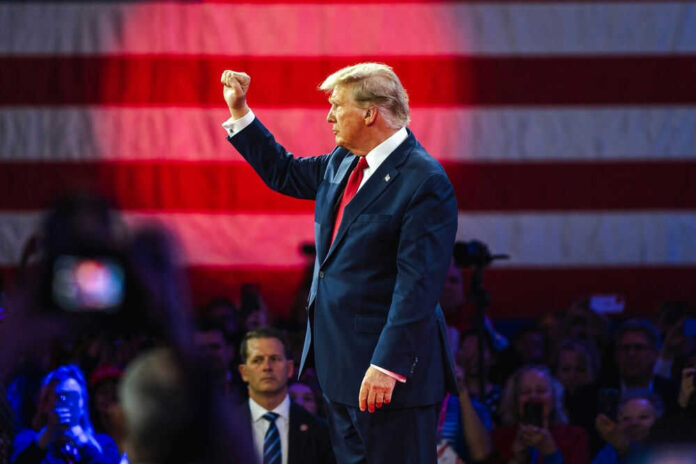
President Trump’s new tariffs on imported trucks and buses deliver a decisive blow against globalist market practices, finally prioritizing American manufacturers and national security over foreign interests.
Story Snapshot
- Trump signs a proclamation imposing 25% tariffs on imported medium- and heavy-duty trucks and 10% on buses, effective November 1, 2025.
- Tariffs target foreign competition, especially Mexico, aiming to revitalize U.S. manufacturing and protect national security.
- U.S. automakers receive extended relief and production credits to support domestic assembly.
- Expert opinions highlight both economic benefits for American jobs and risks of higher prices or trade retaliation.
Trump’s Tariffs: A Strategic Move to Protect American Industry
President Donald Trump signed a proclamation imposing steep tariffs on imported medium- and heavy-duty trucks and parts at 25%, and buses at 10%.
These new trade barriers, set to take effect on November 1, represent a clear shift toward protectionist policies, designed to counter decades of globalist overreach that left American manufacturers at a disadvantage.
The administration’s actions fall under Section 232 of the Trade Expansion Act, citing national security as the driving force behind the move. This marks a substantial escalation in safeguarding U.S. jobs and industrial capacity, especially in sectors vital for military and economic infrastructure.
For years, foreign industrial policies fueled America’s reliance on imported trucks and bus parts, with nearly 43% of all trucks sold in the U.S. coming from overseas. Previous administrations failed to address this vulnerability, leaving critical infrastructure exposed to supply chain disruptions and foreign market manipulation.
The Trump administration’s decision comes after a comprehensive Section 232 investigation by the Department of Commerce, which found that unchecked imports posed a clear threat to national security.
By targeting foreign manufacturers—most notably in Mexico—with tariffs, Trump aims to restore control over strategic industries and incentivize domestic investment.
Relief Measures and Credits for U.S. Automakers
In tandem with these tariffs, the administration extended tariff relief for American automakers through 2030, including a 3.75% production credit for domestically assembled vehicles and engines.
This relief provides a critical buffer for U.S. companies facing higher costs on imported parts while rewarding those who prioritize American assembly lines. U.S. Customs and Border Protection will oversee implementation, ensuring compliance for vehicles produced under USMCA guidelines.
These measures reflect a deliberate effort to strengthen American manufacturing, preserve jobs, and reduce dependency on foreign supply chains.
Senior officials have emphasized that these trade actions incentivize domestic manufacturing and protect American workers.
The administration maintains regulatory authority, while automakers and foreign competitors must adapt to new market realities. USMCA countries benefit from partial exemptions, illustrating the complexity and negotiated nature of modern trade relationships.
The relief and credits are designed to support U.S. competitiveness without encouraging further outsourcing or offshoring, a persistent complaint among conservative voters.
Immediate and Long-Term Consequences
Short-term effects include increased costs for imported trucks, parts, and buses, with foreign manufacturers—especially those in Mexico—facing immediate losses in U.S. market share. American companies stand to gain, offsetting costs through credits and benefiting from reduced competition.
In the long run, the policy may incentivize the reshoring of manufacturing, fortify domestic supply chains, and create new jobs for American workers. However, industry analysts caution that consumers could see higher vehicle prices, and international trade partners may retaliate, potentially impacting exports in other sectors.
These tariffs signal a bold reaffirmation of conservative values: defending American jobs, restoring industrial sovereignty, and rejecting globalist economic agendas.
The move also highlights the administration’s resolve to use executive power to protect the Constitution, national security, and the economic future of American families.
While experts remain divided on the long-term impact, supporters argue that strategic protectionism is necessary to maintain critical infrastructure and economic resilience.
Critics, meanwhile, warn of market inefficiencies and possible trade wars, but the administration counters that national security must take precedence over short-term price concerns.
As implementation proceeds, U.S. truck and bus manufacturers prepare for increased investment in domestic facilities, while foreign competitors scramble to adjust to new rules.
American consumers and businesses may face higher prices, but the underlying objective is clear: restoring American strength and independence in industries essential to national security.
The Trump administration’s strategy exemplifies the fight against government overreach and reckless globalism, rallying conservative voters who demand accountability, constitutional protection, and common-sense policy solutions.
Sources:
Trump Signs Proclamation Imposing Tariffs on Truck and Bus Imports – CBS News
Trump Tariffs: Truck, Car Imports Hit With Duties – Axios
Trump Extends Auto Tariff Relief, Imposes Truck and Bus Duties – Bloomberg
Section 232 Tariffs on Heavy & Medium Duty Trucks and Buses Effective Nov 1 – GHY



















